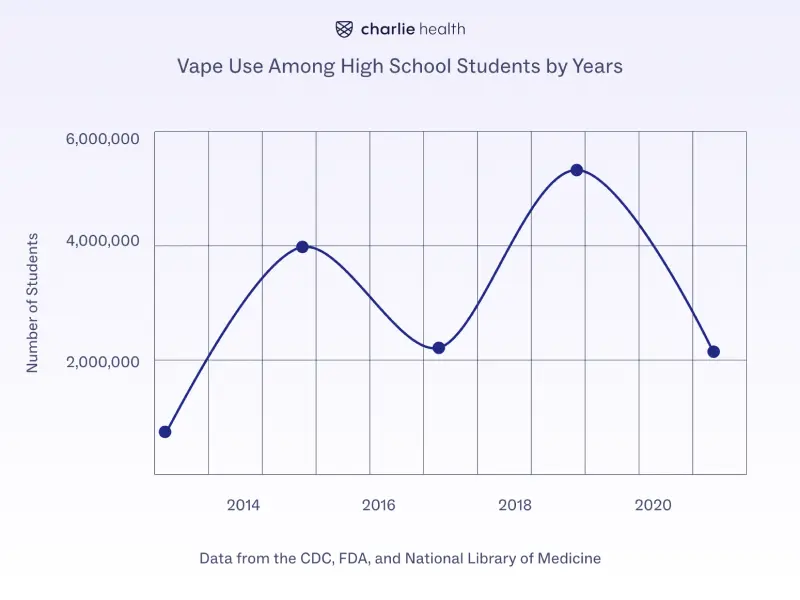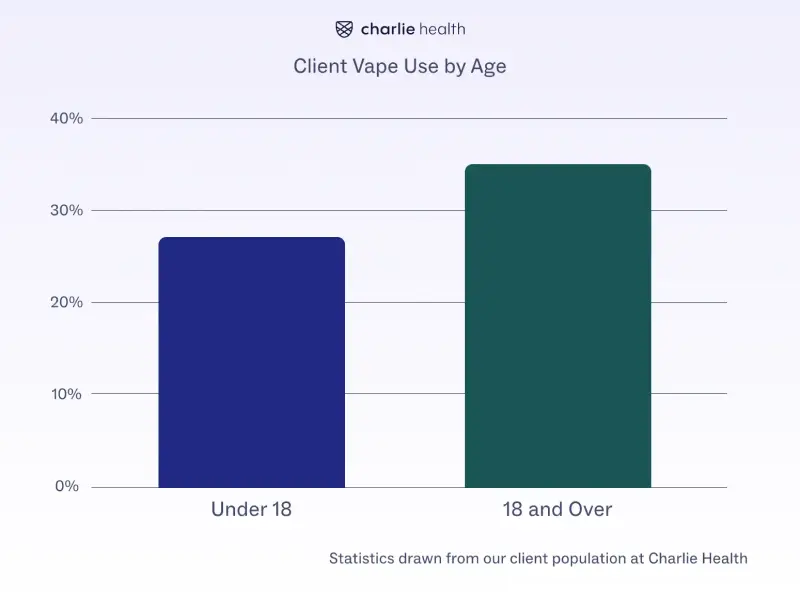
Table of Contents
Nicotine, Vaping, and Anxiety: What You Need to Know

Written By: Colin Crouse

Clinically Reviewed By: Dr. Kate Gliske
Updated: July 13, 2023
7 min.
The physical consequences of vaping and nicotine are obvious––but what about the mental health impact? We explore how vaping plays a role in heightened teen anxiety.
Learn more about our Clinical Review Process
Table of Contents
What is nicotine?
Nicotine, found in tobacco products such as cigarettes and chewing tobacco, is one of the top five most addictive drugs in the world. It is also the active ingredient in the e-liquid of most e-cigarettes, also referred to as “vapes.”
Regardless of the way it’s consumed, nicotine, in general, has been associated with the development and exacerbation of mental health symptoms, particularly anxiety and depression.
What are e-cigarettes?
Electronic cigarettes, commonly referred to as “vapes” or “e-cigs,” are battery-powered devices that deliver vapor to users by heating a liquid solution containing nicotine, also known as e-liquid. E-cigarettes come in a variety of sizes, shapes, and flavors. Due to their increasing popularity, e-cigarettes are widely available throughout the country and are the most commonly used nicotine products among youth in America.
While vapes are perceived by many to be safer than traditional nicotine products such as cigarettes, studies have shown that vapes often can contain a much higher nicotine concentration than any other tobacco product, raising major concerns over the mental and physical wellness of vape users. Furthermore, vape use has been linked to severe medical conditions such as popcorn lung and even collapsed lungs, according to medical professionals at Johns Hopkins Medicine.

What is anxiety?
While there are many different types of anxiety disorders, several of them share similar symptoms and characteristics. An anxiety disorder can be characterized by persistent worrying or fears surrounding typical everyday situations, leading to a lack of or reduced functioning in individuals’ lives. Anxiety can lead to racing thoughts, intense feelings of terror, fear, or even a sense of impending doom.
Sometimes these anxious thoughts and feelings can become so intense they result in what are known as panic attacks. A panic attack is a debilitating wave of intense fear, often quickly followed by uncomfortable physical symptoms such as increased heart rate, sweating, and hyperventilation. People experiencing panic attacks might feel a sense of complete loss of control or, in some cases, might even feel they are near death.
Other common psychological symptoms of anxiety disorders may include:
- Persistent worrying or fears
- Rapid thinking
- Intrusive thoughts
- Restlessness or irritability
- Difficulty concentrating
- Trouble sleeping
- Dissociative episodes
Physical effects of anxiety
While anxiety is a psychological disorder, it often presents with a variety of physical symptoms as well. As mentioned, these physical sensations can become exacerbated if one’s anxiety escalates to the level of panic. There have been many documented cases of people being admitted to hospitals over suspected heart attacks or other cardiac episodes, only to find they were experiencing panic attacks.
Common physical symptoms of anxiety disorders may include:
- Increased heart rate or heart palpitations
- Increased sweating
- Shaking
- Stomach pain or nausea
- Chills
- Hot flashes
- Chest pain
- Back pain
- Numbness or tingling sensation throughout the hands, head, and body
- Difficulty breathing
- Dizziness
- Hyperventilating
- Weakness or tiredness
- Gastrointestinal issues
Nicotine and anxiety
The relationship between anxiety and nicotine is cyclical. People may lean on nicotine products such as vapes or cigarettes as a crutch to alleviate stress or the immediate symptoms of anxiety, only to find their anxiety has become worse later on. This may be especially true for young people, whose developing brains are even more vulnerable to the detrimental and lasting effects of nicotine use.
A 2019 study found anxiety to be a significant risk factor for nicotine use later in life, meaning those who are already prone to anxiety are also more likely to consume nicotine products and become nicotine dependent. Furthermore, the same study found that adolescents and young adults who were nicotine dependent, including daily cigarette smokers or vapers, were at a higher risk of experiencing anxiety than those who were not nicotine dependent.
While being a significant risk factor for future anxiety disorders, nicotine use can also make it more difficult for individuals to recover from their anxiety. A 2012 study found that nicotine users suffering from anxiety and depression improved at a slower rate over a two-year period than those that did not use nicotine.
Teen and young adult vaping: Data from Charlie Health
Previous research has found that individuals with mental health conditions are more likely to use nicotine products than those without mental health issues such as anxiety. Charlie Health is a nationwide virtual Intensive Outpatient Program (IOP) for youth and young adults (11- to 33-year-olds) struggling with a variety of mental health disorders, including major depressive disorder and generalized anxiety disorder. Charlie Health collects a variety of data from clients in an effort to provide the highest quality personalized care possible.
In a sample of 3,197 youth and young adults admitted to Charlie Health’s IOP in the second half of 2022:
- 30% reported using vapes at least once in the past 30 days
- 21.1% of these individuals reported weekly or daily use
By comparison, in 2021, the CDC estimated that 11.3% of all high school students in America were using e-cigarettes
Prevalence of e-cigarette use varied by gender. The following percentage of gender identities reported using vapes or e-cigarettes:
- 28.1% of male clients
- 30.6% of female clients
- 34.7% of non-binary clients
Of the clients that reported vape use in the past 30 days:
- 27.8% were under 18
- 33.1% were over 18

Additionally, of the total client population of Charlie Health surveyed about traditional tobacco products such as cigarettes or chewing tobacco:
- 15.6% report using traditional tobacco products in the past 30 days
- 11.5% of these individuals reported weekly or daily use
Of the clients who reported traditional tobacco use:
- 15.8% were male
- 15.3% were female
- 17.9% were non-binary
Of the clients that reported tobacco use in the past 30 days:
- 12.6% were under the age of 18
- 19% were 18 or older
Nicotine use in adolescents and young adults is especially problematic given the ongoing brain development occurring throughout these developmental periods. Young people who use nicotine are at a significantly higher risk of experiencing the psychological and physical repercussions of nicotine use. Previous research has also established this population is significantly more likely to engage in the co-using of other substances such as alcohol, marijuana, and other nicotine products.
Nicotine withdrawal
Nicotine withdrawal occurs when someone stops using nicotine for a prolonged period of time. On average, withdrawal symptoms can last between two to four weeks. However, nicotine withdrawal might last longer based on how long someone has been using nicotine and how dependent they were. While nicotine withdrawal syndrome is associated with a variety of symptoms, the American Psychiatric Association lists anxiety as one of the seven most common nicotine withdrawal symptoms. Other common nicotine withdrawal symptoms include nicotine cravings, depression, restlessness, irritability, headaches, trouble concentrating, body or mental fatigue, increased appetite, and insomnia.
Nicotine withdrawal and anxiety
Since anxiety is one of the most common symptoms of nicotine withdrawal syndrome, those who are already suffering from an anxiety disorder may find their anxiety intensifies when they try to quit using nicotine products. For this reason, many people who are already experiencing high levels of anxiety may find it difficult to stop using nicotine. While in the short term, an individual’s anxiety will likely become exacerbated while going through withdrawals, studies have shown that people who are nicotine-free recover from psychological disorders such as anxiety and depression at a significantly higher rate than those who use nicotine. So while quitting may be uncomfortable or even painful at first, in the long run, most individuals that quit nicotine will benefit from an overall improvement in their mental health.
While nicotine withdrawal and the anxiety it causes can become uncomfortable for many people, there are many techniques you can utilize to minimize its effects. Here are some of the best ways experts agree on to combat the effects of nicotine withdrawal:
- Nicotine cessation therapy
- Exercise
- Yoga
- Meditation
- Mindfulness practices such as deep breathing exercises
- Chewing gum or hard candy to keep your mouth busy
Vaping and overall mental health
Previous studies have found several significant associations between nicotine use and anxiety. Individuals with anxiety disorders are more likely to use nicotine products and experience the negative psychological and physical effects of nicotine and its withdrawal symptoms. Individuals that use nicotine may also recover from mental health disorders such as anxiety and depression at a slower rate than those who do not. Furthermore, people who might not even have anxiety disorders but use nicotine products are more likely to develop anxiety due to the drug’s effect on the human brain. Because their brains continue to develop into their mid-20s, young people are especially susceptible to the effects of nicotine and are more at risk of developing anxiety disorders from nicotine use.
Anxiety support at Charlie Health
Vaping is a highly addictive habit with serious physical and mental health consequences, including an increased risk of anxiety and depression.
We’re here to help.
We specialize in creating personalized care programs with multi-weekly therapy sessions for teens and young adults. Get started with our virtual IOP today.
References
Roche, D. J. O., Bujarski, S., Green, R., Hartwell, E. E., Leventhal, A. M., & Ray, L. A. (2019). Alcohol, tobacco, and marijuana consumption is associated with increased odds of same-day substance co- and tri-use. Drug and Alcohol Dependence, 200, 40–49. https://doi.org/10.1016/j.drugalcdep.2019.02.035
Cummins, S. E., Zhu, S.-H., Tedeschi, G. J., Gamst, A. C., & Myers, M. G. (2014). Use of e-cigarettes by individuals with mental health conditions. Tobacco Control, 23 Suppl 3(Suppl 3), iii48-53. https://doi.org/10.1136/tobaccocontrol-2013-051511
Picciotto, M. R., Brunzell, D. H., & Caldarone, B. J. (2002). Effect of nicotine and nicotinic receptors on anxiety and depression. 10.
McLaughlin, I., Dani, J. A., & De Biasi, M. (2015). Nicotine Withdrawal. Current Topics in Behavioral Neurosciences, 24, 99–123. https://doi.org/10.1007/978-3-319-13482-6_4
Tips for Coping with Nicotine Withdrawal and Triggers—NCI (nciglobal,ncienterprise). (2022, January 13). [CgvArticle]. https://www.cancer.gov/about-cancer/causes-prevention/risk/tobacco/withdrawal-fact-sheet
Morean, M. E., Kong, G., Cavallo, D. A., Camenga, D. R., & Krishnan, Sarin, S. (2016). Nicotine concentration of e-cigarettes used by adolescents. Drug and Alcohol Dependence.
Jamal, M., Willem Van der Does, A. J., Cuijpers, P., & Penninx, B. W. J. H. (2012). Association of smoking and nicotine dependence with severity and course of symptoms in patients with depressive or anxiety disorder. Drug and Alcohol Dependence, 126(1), 138–146. https://doi.org/10.1016/j.drugalcdep.2012.05.001
England, L. J., Bunnell, R. E., Pechacek, T. F., Tong, V. T., & McAfee, T. A. (2015). Nicotine and the Developing Human: A Neglected Element in the Electronic Cigarette Debate. American Journal of Preventive Medicine, 49(2), 286–293. https://doi.org/10.1016/j.amepre.2015.01.015
Morean, M. E., Kong, G., Cavallo, D. A., Camenga, D. R., & Krishnan‐Sarin, S. (2016). Nicotine concentration of e-cigarettes used by adolescents. Drug and Alcohol Dependence.
Lung Capacity and Aging. (2022). Retrieved October 18, 2022, from https://www.lung.org/lung-health-diseases/how-lungs-work/lung-capacity-and-aging
Yan, Y., Sun, S., Deng, S., Jiang, J., Duan, F., Song, C., Wang, K., Zhang, N., Tian, Q., & Nie, W. (2019). A systematic review of anxiety across smoking stages in adolescents and young adults. Substance Use & Misuse, 54(8), 1408–1415. https://doi.org/10.1080/10826084.2019.1581222
Huffman, J. C., Pollack, M. H., & Stern, T. A. (2002). Panic Disorder and Chest Pain: Mechanisms, Morbidity, and Management. Primary Care Companion to The Journal of Clinical Psychiatry, 4(2), 54–62.
Anxiety disorders—Symptoms and causes. (2018). Mayo Clinic. Retrieved November 16, 2022, from https://www.mayoclinic.org/diseases-conditions/anxiety/symptoms-causes/syc-20350961
Panic Disorder: When Fear Overwhelms. (2022). National Institute of Mental Health (NIMH). Retrieved November 17, 2022, from https://www.nimh.nih.gov/health/publications/panic-disorder-when-fear-overwhelms
Panic attacks and panic disorder—Symptoms and causes. (2018). Mayo Clinic. Retrieved November 18, 2022, from https://www.mayoclinic.org/diseases-conditions/panic-attacks/symptoms-causes/syc-20376021


